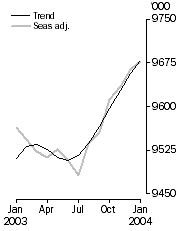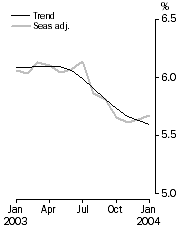January Key Figures
 |
 |  | Dec 2003 | Jan 2004 | Dec 03 to Jan 04 | Jan 03 to Jan 04 |  |
|  |
| Trend |  |  |  |  |  |  |  |
 | Employed persons ('000) | 9,656.6 | 9,679.7 | 23.1 |  | 1.8 | % |  |
 | Unemployed persons ('000) | 575.8 | 574.1 | -1.7 |  | -6.8 | % |  |
 | Unemployment rate (%) | 5.6 | 5.6 | 0.0 | pts | -0.5 | pts |  |
 | Participation rate (%) | 63.8 | 63.8 | 0.0 | pts | -0.4 | pts |  |
| Seasonally Adjusted |  |  |  |  |  |  |  |
 | Employed persons ('000) | 9,664.4 | 9,678.3 | 13.9 |  | 1.2 | % |  |
 | Unemployed persons ('000) | 577.9 | 582.7 | 4.8 |  | -5.5 | % |  |
 | Unemployment rate (%) | 5.6 | 5.7 | 0.0 | pts | -0.4 | pts |  |
 | Participation rate (%) | 63.8 | 63.8 | 0.0 | pts | -0.7 | pts |  |
|  |
Employed persons

| Unemployment rate

|
January Key Points
TREND ESTIMATES (Monthly Change)
- EMPLOYMENT increased to 9,679,700.
- UNEMPLOYMENT decreased to 574,100.
- UNEMPLOYMENT RATE remained at 5.6%.
- PARTICIPATION RATE remained at 63.8%.
SEASONALLY ADJUSTED ESTIMATES (Monthly Change)
EMPLOYMENT
- increased by 13,900 to 9,678,300. Full-time employment increased by 29,900 to 6,955,400 and part-time employment decreased by 16,000 to 2,722,900.
UNEMPLOYMENT
- increased by 4,800 to 582,700. The number of persons looking for full-time work increased slightly to 425,600 and the number of persons looking for part-time work increased by 4,400 to 157,100.
UNEMPLOYMENT RATE
- increased marginally to 5.7%. The male unemployment rate increased by 0.1 percentage point to 5.4% and the female rate remained at 6.1%.
PARTICIPATION RATE
Notes
CHANGES TO SEASONAL ADJUSTMENT PROCESSES
Users are reminded that, under the concurrent seasonal adjustment method used for Labour Force Survey (LFS) estimates since December 2003, seasonally adjusted estimates will now (potentially) be revised each month. See paragraphs 17 to 21 of Explanatory Notes for further information.
CAI IMPLEMENTATION
In October 2003, the ABS began the progressive implementation of computer assisted interviewing (CAI) into the LFS. Under CAI, interviewers record responses directly onto an electronic questionnaire in a laptop computer.
For the period October 2003 to January 2004 the CAI method was used on a random 10% sub-sample of survey interviews. The remaining 90% of interviews each month were conducted using the traditional 'pen and paper' method.
The ABS had planned to increase the sub-sample of survey interviews conducted using the CAI method from 10% to 40% in February 2004. However, a number of technical problems has prevented this. The CAI sub-sample will now be increased from 10% to 40% in February 2004 in New South Wales, Victoria, South Australia and the Australian Capital Territory only. Nationally this represents an increase in CAI interviews from 10% to about 28%. The effects of these technical problems may delay the full implementation of CAI.
The change to the interviewing method is not expected to affect the published estimates in any meaningful way. Nonetheless, the ABS is monitoring the situation carefully and has conducted a range of analyses on each month's data. These analyses have confirmed that any effect that the change in interview method in the 10% CAI sub-sample may have had on survey responses has not materially affected the aggregate estimates for any month.
Subject to further analysis continuing to confirm that the change in method is not having a significant impact on survey estimates, the ABS intends to progressively increase the use of CAI. Users will continue to be informed of the progress of CAI implementation, including the results of further analyses, through updates in this publication.
Inquiries
For further information about these and related statistics, contact the National Information and Referral Service on 1300 135 070 or Craig Blair on Canberra 02 6252 6525.
Forthcoming changes
REVISIONS TO UNIT RECORD DATA
The ABS will be introducing a number of changes to labour force statistics with the release of February 2004 LFS data. These changes involve revisions to detailed original data at the unit record level which will flow through to published aggregated data.
The ABS will release a complete set of revised estimates when February 2004 data is released on 11 March 2004.
The changes which will impact upon this publication and associated electronic products are detailed below. Further information on all the changes is available in Information Paper: Forthcoming Changes to Labour Force Statistics (cat. no. 6292.0), released on 16 December 2003. This information paper is available free from the ABS web site .
REVISION OF POPULATION BENCHMARKS
LFS estimates of persons employed, unemployed and not in the labour force are calculated in such a way as to add up to independent estimates of the civilian population aged 15 and over (population benchmarks). These population benchmarks are revised every five years following the Census of Population and Housing. From February 2004, LFS estimates will be compiled using revised population benchmarks based on results from the 2001 Census. LFS estimates for the period January 1999 to January 2004 will also be revised based on the updated population benchmarks.
The population benchmarks currently used by the LFS are classified by state/territory of usual residence, capital city/rest of state, age and sex. In addition to these population benchmarks, from February 2004 the LFS will use population benchmarks for labour force region by sex. There are currently 68 labour force regions across Australia. The introduction of regional benchmarks will improve the quality of estimates for labour force regions without compromising the quality of estimates at national, state and territory levels.
LFS estimates for labour force regions (available each month in electronic products) will be revised back to January 1999.
DEFINITIONAL CHANGE
In February 2004, the ABS will introduce a minor change to the definition of unemployed persons. The change relates to a small group of persons ('future starters') who had not actively looked for work because they were waiting to start a new job within four weeks from the end of the survey reference week, and would have started in the reference week if the job had been available then. These persons are currently classified as not in the labour force. From February 2004 they will be classified as unemployed, in line with International Labour Organisation guidelines.
Data to support this change has been available since the new LFS questionnaire was introduced in April 2001. However, the ABS announced then that, due to concerns that such a change could result in a break in some core labour force series, implementation of the change would be deferred until February 2004 (see Information Paper: Implementing the Redesigned Labour Force Survey Questionnaire (cat. no. 6295.0) which was released on 3 May 2001). This timing coincides with the five-yearly revision of population benchmarks mentioned above.
LFS estimates will be revised back to April 2001 to reflect this change. Analysis has shown that the unemployment rate will increase as a result of this definitional change by an average of 0.1 - 0.2 percentage points. A small break will remain in the unemployed persons and unemployment rate series at April 2001.
EMPLOYED PERSONS
The trend estimate of employed persons generally rose from a low of 7,637,500 in December 1992 to 9,133,200 in September 2000. The trend estimate then fell slightly to 9,106,800 in January 2001, before rising to 9,534,600 in March 2003. The trend estimate then fell for three months, and has since risen to stand at 9,679,700 in January 2004.
UNEMPLOYED PERSONS
The trend estimate of unemployed persons fell rapidly from 920,700 in September 1993 to 728,200 in July 1995. The trend estimate then rose to 771,500 in February 1997, before falling to 592,300 in September 2000. After rising to 678,300 in October 2001, the trend estimate has generally fallen to stand at 574,100 in January 2004.
UNEMPLOYMENT RATE
The trend unemployment rate fell rapidly from 10.7% in August 1993 to 8.1% in July 1995. The trend estimate then rose slowly, reaching 8.4% in February 1997, before falling to 6.1% in September 2000. After rising to 6.9% in September 2001, the trend estimate has generally fallen to stand at 5.6% in January 2004.
 Print Page
Print Page
 Print All
Print All